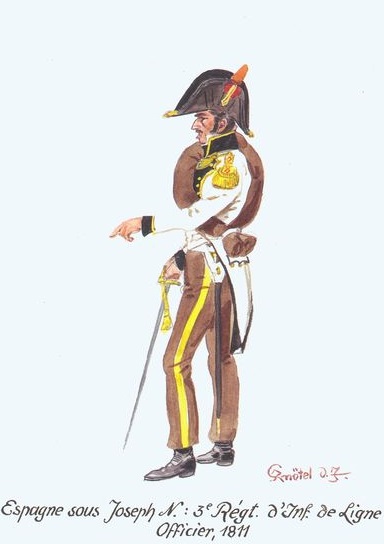The Contingents of the Ducal Houses of Saxony
The Contingents of the Ducal Houses of Saxony
 |
| The Ducal Houses of Saxony are located to the west of Saxony, i.e. Central Germany |
The Confederation of the Rhine states ALL had military contingents they were forced to give to Napoleon. Most Confederation of the Rhine states maintained extra military units for internal service, along with some type of militia. During 1807-1810 these troops gradually shed their old Prussian-style uniforms, with their long tailed cutaway coats and black bicorne hats, to adopt this thoroughly French style.
White trousers might be worn for summer, with short black gaiters.
Saxe-Gotha-Altenburg
Fusilier Corporal, 1812
This corporal has a French-type shako and the habit-veste. Note the white crossbelts, and his briquet scabbard behind his left leg.
Saxe-Meiningen
Officer, 1812
Meiningen was slower than Gotha to change uniforms, retaining some of its black leather belts for some years. For both states the cockade was of black leather, trimmed with brass/gold. The white vest is for summer wear.
The tall red plume suggests that this is an officer of a grenadier company. Obviously he is expressing something like a German version of “Come on you sons-a-bitches! You want to live forever?”
Saxe-Weimar
Sharpshooter, 1806
Formed in 1788 this battalion was originally all riflemen. This odd-looking headgear actually was a variant of the “miter cap” then worn by most grenadiers; it was replaced by a bicorne chapeau in 1807, later by a shako.
Note the distinctive red stock. His rolled grey cloak is slantwise across his back. The slender staff slung over his left shoulder is probably a form of “Swede’s (or Swine’s) feather” which could be used as a rest to steady his aim or inserted into the bore of his stubby rifle to serve as a sort of bayonet against cavalry.
Carabinier Sergeant, 1812
This is the final evolution of the uniform before, as worn by the light infantry battalion’s elite carabinier company. This company was identified by its tall scarlet plume and pompon, shako cords and epaulets, as well as the “flaming grenade” at the top of the shako plate. (Chasseur companies had only the lower portion, a conventionalized hunting horn, the traditional symbol for light troops.) The scarlet band around the top of shako probably is a sergeant’s distinction, along with the half-chevrons on his forearms - which probably should be gold.
By this time only the rear/third rank men were armed with rifles - undoubtedly because units armed only with that weapon had proven too vulnerable to cavalry or bayonet attacks.
Hussar Private, 1812
This unit (probably no more than a squadron) was not part of the Saxe-Weimar contingent, being used for escort, courier, and constabulary duties within that duchy. Schabraque and sabretache carry the duke’s cipher.
Until about 1808, the hussars wore the earlier mirliton type of shako, with a black flamme, edged with red-and-white lace. (This unit and its distinctive uniform lasted from the early 18th century until 1914.)Saxe-Coburg-Saalfeld
Grenadier, 1812
Like the Saxe-Weimar hussars, this was not a part of its duchy’s contingent, though it later saw service in Spain, and probably Russia.
Peculiarly, grenadiers are shown with these red-braided green coat-skirt turnbacks instead of the all red worn by other troops (compare it to the bandsman below). Other sources show strips of white lace at the cuff buttonholes. This gaudy uniform must have contrasted strongly with dark blue of Saxe-Gotha and Saxe-Meiningen!
Bandsman, 1812
This band’s exact service is obscure. Probably it did go to Russia in 1812. The instrument is apparently a type of bassoon; it illustrates a common whimsy of the period - to give wind instruments reptiles’ heads.










Comments
Post a Comment